
Mindeparken (English: The Memorial Park) is a memorial park and recreational area in the south of Aarhus City, next to Marselisborg Palace.

Mindeparken (English: The Memorial Park) is a memorial park and recreational area in the south of Aarhus City, next to Marselisborg Palace.
The Park itself, was inaugurated in 1925 by king Christian X and originally designed to accommodate larger gatherings of visiting Danish citizens living abroad. That role soon diminished and disappeared, as the annual gatherings in Rebild gained momentum.
In 1934 a large monument in limestone, engraved with the names of and commemorating the 4,140 Danes killed in World War I, was erected. Designed by the Danish architect Axel Ekberg and Danish sculptor Axel Poulsen, they choose limestone from Euville in the Meuse department of France, a major battlefield in World War I. The memorial site is still in active use today and on 11 November, an annual ceremony is held here in memory of the dead.
In 2012, a stone for Danish soldiers stationed abroad, was erected in the park.
Surrounding the memorial monument is a large park and lawn area, used for all kinds of gatherings, events and recreational activities by the citizens of Aarhus. The park offers a panoramic view across the Bay of Aarhus. Mindeparken was extended in 1939 and again in 1944, and now includes different sections with their own peculiarities. In a corner of the park is Træsamlingen (The Tree Collection), a botanical selection of different tree species and nearby is Rømerhaven (The Rømer Garden), a sculpture and flower garden with a botanical bend.
In the south of Mindeparken lies the Donbæk Houses, built in 1828 and 1850. They formerly served as residentials of the servants to the baron of Marselisborg Manor, and also housing for forest workers in the Marselisborg Forests at some point. The old Marselisborg Manor was located where Marselisborg Gymnasium has residence now, but caught fire several times in the early 1900s and does not exist anymore. The Donbæk Houses are thus not related to the Marselisborg Palace, a common misconception.
World War I monument
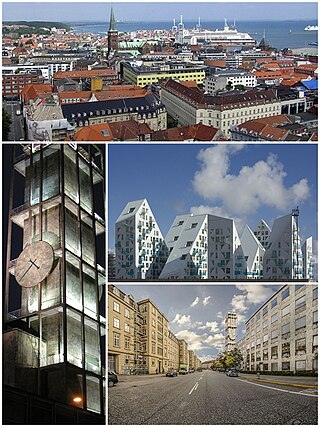
Aarhus is the second-largest city in Denmark and the seat of Aarhus Municipality. It is located on the eastern shore of Jutland in the Kattegat sea and approximately 187 kilometres (116 mi) northwest of Copenhagen.

Marselisborg Palace, is a royal residence of the Danish Royal Family in Aarhus. It has been the summer residence of Queen Margrethe II since 1967.

Skåde is a neighbourhood of Højbjerg, a southern district of Aarhus in Denmark. It is located 6 km south from the city centre.

Aarhus Botanical Gardens is a botanical garden in Aarhus, Denmark. It is located north of the Old Town open-air village museum and was founded in 1875. Nowadays it covers an area of 21.5 hectares, with 5 hectares for the Old Town.

Riis Skov is a forest and park in Århus, Denmark. It is located south of the district of Risskov, along the Bay of Aarhus.

Skjoldhøjkilen is a recreational and natural site, in the district of Brabrand in the western part of Aarhus in Denmark. It stretches westwards from Hasle Hills, like a wavy green strip of meadows, small lakes and woodlands. It is 3.5 km long and just as Hasle Hills, it is administered by the self-governing institution 'Hasle Bakker'.

Aarhus Forestry Botanical Garden is a forestry botanical garden located in the south of Aarhus, Denmark. It forms a small part of the northern section of Marselisborg Forests and is situated right next to Marselisborg Palace and Mindeparken. The botanical garden was established in 1923.

Marselisborg Forests, or simply Marselisborg Forest, is a 550 hectares forest to the south of Aarhus City in the Kingdom of Denmark. Many present day sources now includes the forest of Fløjstrup, as part of the Marselisborg Forests, upping the total area with another 200 hectares. Marselisborg Forests runs along the coastline of the Aarhus Bay in a hilly terrain with steep slopes and deep gullies, especially at the shoreline. There are many traces of prehistoric activities here and the landscape have been covered by woodlands for thousands of years.

Marselisborg Deer Park is a 22 hectares enclosed woodland area in the northern parts of the Marselisborg Forests. The trees are somewhat sparse here and the terrain especially hilly, compared to the surrounding forest.
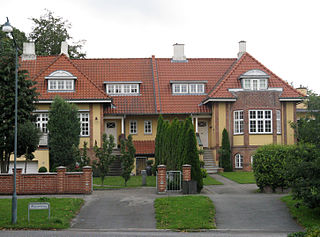
Marselisborg is a small borough of Aarhus, Denmark. Being small and situated just south of Frederiksbjerg, Marselisborg is often considered part of Frederiksbjerg.
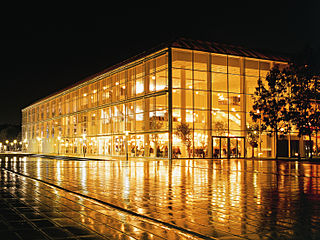
Musikhuset Aarhus is a large concert hall complex in Aarhus, Denmark. Located in the city centre, Musikhuset is Aarhus' main venue for music and with seating for more than 3,600 people in total, it is the largest concert hall in Scandinavia. Musikhuset Aarhus was designed by Kjær & Richter and built in 1979-1982, commissioned by Aarhus Municipality.

Rikard Axel Poulsen was a Danish sculptor. He is remembered for his memorials in Copenhagen's Fælledparken and Aarhus' Marselisborg Mindeparken.
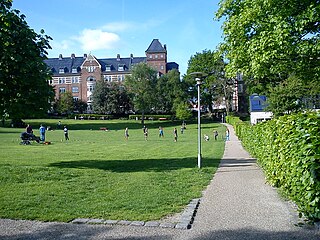
Skanseparken is one of the oldest parks in the city of Aarhus. It is situated in the neighborhood of Frederiksbjerg in Midtbyen. Skanseparken was constructed in the years 1901 to 1902 between the streets Strandvejen, Marselisborg Allé and Heibergsgade. The park is typical of the parks in the city with large, open areas bounded by beech trees, raised flower beds and playgrounds. It is a popular area for festivals, concerts and other cultural events.

Tangkrogen is a public park in Aarhus, Denmark. The park is situated in the neighborhood Midtbyen by the coast with the Bay of Aarhus to the southeast, the Marselisborg neighborhood to the West and the Port of Aarhus to the North. The park is bounded by Strandvejen and Marselis Havnevej across from Chr. Filtenborgs Square. It is a municipal park managed by the Nature and Environment department of Aarhus Municipality. Tangkrogen got its name from the kelp that filled the cove when recreational jetties were constructed when the city of Aarhus initially developed the area into a public park in the early 20th century.

St. Oluf Cemetery is a small public park and historic site in central Aarhus, Denmark. The park is situated by the coast in the city center of Midtbyen, in the Latin Quarter, bounded by the streets of Kystvejen and St. Olufs Stræde, overlooking the Docklands and the Bay of Aarhus in the East. It is one of only two green spaces in the historic inner city, the other one being Frue Kirkeplads at the Church of Our Lady, but is one of five protected scheduled monuments.
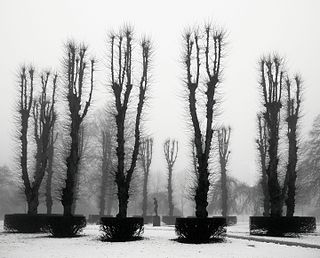
Rådhusparken is a public park in central Aarhus, Denmark. The park is situated by the City Hall in the Indre By neighborhood of Midtbyen, between the streets Frederiks Allé to the west and Park Allé to the east. The park lies within a scenic semi-circle of some of the more important cultural and political institutions in the city; the Concert Hall, the ARoS Art Museum, Vester Allés Kaserne and the city hall. The City Hall Park was listed along with the adjacent city hall on 10 March 1995.

Marselisborgcentret, formerly Marselisborg Hospital, is a rehabilitation hospital in Aarhus, situated on P. P. Ørums Gade in the borough of Marselisborg. The original hospital was established in 1913 and has been repurposed for rehabilitation, including related research and innovation, in 2001.

Marselisborg was a farm, manor and barony in Aarhus, Denmark which existed through the 1200s to 1910 under varying ownership and status. The original farm was situated in the present day Marselisborg neighborhood south of the city centre. In 1896 the city of Aarhus purchased the manor and in 1911 dissolved the estate and sold the land off for development. The manor was named after and by Gabriel Marselis who was the first private owner and many landmarks in the area are in turn named for the manor such as Marselisborg Forests, Marselisborg Hospital and Marselisborg Palace.
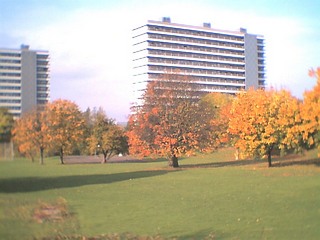
Langenæs Park is a public park in the Langenæs neighborhood in the Aarhus C district in Aarhus, Denmark. The park is situated west of the Frederiksbjerg neighborhood along the curved street Langenæs Allé to the south and the AArhus rail yard to the north. Langenæs Park is one of the largest parks in Aarhus and is composed of mainly landscaped lawns with trees scattered throughout along with a large section dedicated to sports. Facilities include soccer fields, a disc gold field, picnic areas and a paved running track. Langenæs Park was established in connection with the development of the Langenæs neighborhood in the 1970s and is today the primary recreational spot in the area along with Frederiksbjerg Bypark to the west and the Rehabilitation PArk to the south. The park is owned by Aarhus Municipality and is managed by the municipal department Natur og Miljø and can be rented for public events.
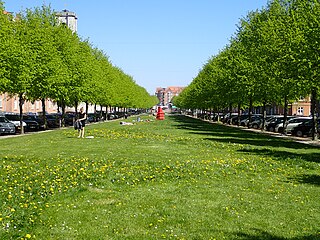
Ingerslevs Boulevard is a street in Aarhus, Denmark. It is 500 meters long and runs west to east from Harald Jensen's Plads to Skt. Anna Gade. The street is situated in the Frederiksbjerg neighborhood where it is functionally the main street but parts of it also acts as a public green space owing to width and central lawn. Ingerslevs Boulevard is home to St. Luke's Church and two schools, N.J. Fjordgade's School and Frederiksbjerg School. It is a mostly residential area but the street itself hosts a farmer's markets twice a week. Ingerslevs Boulevard was developed in the early 20th century as a main component of Frederiksbjerg when the neighborhood was created based on a unified urban planning design.